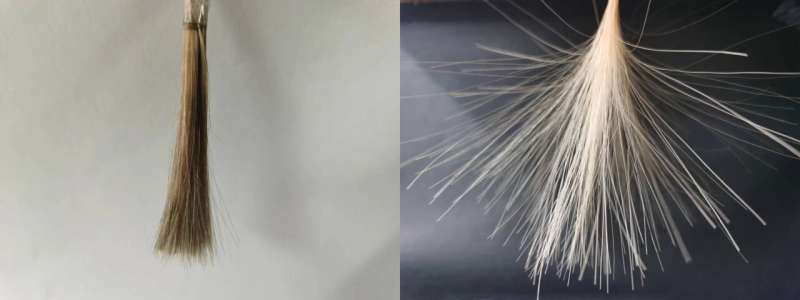Creating a better wig with chemistry

For some people, wigs are a fun and colorful fashion accessory, but for those with hair loss from alopecia or other conditions, they can provide a real sense of normalcy and boost self-confidence. Whether made from human or synthetic strands, however, most hairpieces lose their luster after being worn day after day. Now, researchers in ACS Applied Materials & Interfaces report a new way to make wigs more durable and long lasting.
Wigs come in all colors of the rainbow and in every style imaginable. Some cover the whole head, while others are “extensions,” sections of hair that clip onto existing locks to make them look fuller or longer. Hairpieces can be made of real human strands or synthetic materials, but either way, washing, UV exposure from the sun and repeated styling can cause these products to become dry and brittle. To extend the wearable life of wigs, some researchers have spray-coated a layer of graphene oxide on them, whereas other teams have immersed wig hairs in a keratin/halloysite nanocomposite. Because it’s difficult to cover an entire hairpiece with these methods, Guang Yang, Huali Nie and colleagues wanted to see if a nanocomposite applied with a tried-and-true approach for coating surfaces with ultrathin films—known as the Langmuir-Blodgett (LB) technique—could improve coverage and increase durability.
The researchers first developed a keratin and graphene oxide nanocomposite as the coating material. To coat hairs with the LB method, they dipped a few human or synthetic hairs into water in a special apparatus with moveable side barriers. After the nanocomposite was spread on the water’s surface with an atomizer, the barriers were moved inward to compress the film—like the trash compactor that almost crushed the heroes in the movie “Star Wars.” After 30 minutes, the researchers lifted the hairs out of the water, and as they did so, the film coated the locks.
Compared to the immersion technique, the LB method provided more coverage. In addition, hairs treated with the LB approach sustained less UV damage, were less prone to breakage and could hold more moisture than those that were simply immersed in the nanocomposite. They also dissipated heat better and generated less static electricity when rubbed with a rubber sheet. The researchers say that the method can be scaled up for use by companies that manufacture wigs.
A new solution for wastewater remediation
Shan Du et al, High-Performance Wigs via the Langmuir–Blodgett Deposition of Keratin/Graphene Oxide Nanocomposite, ACS Applied Materials & Interfaces (2022). DOI: 10.1021/acsami.2c05965
Citation:
Creating a better wig with chemistry (2022, June 13)
retrieved 13 June 2022
from https://phys.org/news/2022-06-wig-chemistry.html
This document is subject to copyright. Apart from any fair dealing for the purpose of private study or research, no
part may be reproduced without the written permission. The content is provided for information purposes only.
For all the latest Science News Click Here
For the latest news and updates, follow us on Google News.

